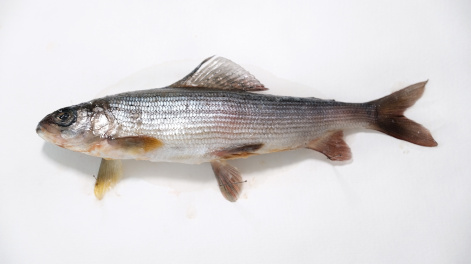Unshaded rivers can provide high value for grayling as a source of beneficial omega-3 PUFAs
27 February 2024 г.

Salmonid fish is valuable commercial fish with high content of physiologically important long-chain polyunsaturated omega-3 fatty acids: eicosapentaenoic acid (EPA) and docosahexaenoic acid (DHA). These are of high value for living beings, including humans. They are needed for the functioning of the cardiovascular and nervous systems. Animals mainly obtain fatty acids from food.
Scientists from the Federal Research Center "Krasnoyarsk Science Center SB RAS" together with colleagues from SibFU have studied the fatty acid composition of grayling Thymallus baicalensis, living in Siberian rivers with different quality of available food and determined how such diets affect the content of EPA and DHA in grayling tissues. Scientists have found that grayling living in shaded rivers has lower nutritional value for humans as a source of fatty acids compared to fish from unshaded rivers.
Scientists have discovered that in forest-shaded rivers in Tamasul, Kutch and Bazaikha, grayling also feed on terrestrial insects with low EPA and DHA content. In contrast, grayling in small, unshaded rivers such as the Mana feed on aquatic insects rich in eicosapentaenoic acid but low in docosahexaenoic acid. In the large, unshaded Yenisei River, the diet of grayling consists of crustaceans - gammarids, feeding on diatoms rich in both eicosapentaenoic and docosahexaenoic acids. Thus, in unshaded rivers, the grayling diet consists of 95% aquatic organisms, and in shaded rivers, a significant proportion of the fish diet (30-40%) consists of terrestrial invertebrates.
Such differences in fish nutrition significantly affected the content of physiologically valuable omega-3 PUFAs and total fatty acids in fish meat and fat. Grayling that live in shaded rivers and feed on terrestrial invertebrates have half the amount of EPA and DHA compared to grayling that live in unshaded rivers. The most valuable source of omega-3 PUFAs for humans was the grayling living in the Yenisei, whose diet consisted exclusively of aquatic invertebrates, and the basis of the food web was diatoms.
“We hypothesized that grayling, living in numerous small forest streams with strong shade, may be deficient in omega-3 PUFAs due to the forest canopy and, as a result, it may be a less valuable source of these substances for consumers at higher trophic levels, including humans. The results of our study indicate that the availability and quality of omega-3 PUFAs in grayling may vary significantly depending on the habitat of the fish. This is important to consider when assessing the nutritional value of fish products. In addition, our study highlights the need for further research to better understand the role of various environmental factors in shaping the quality and availability of nutrients in aquatic ecosystems,” said Pavel Andrushchenko, junior researcher at the Institute of Biophysics SB RAS.
“The nutritional value of fish depends on a large number of factors, the most important of which are the nutritional spectrum and phylogeny. Grayling is a valuable fish species and it is capable of accumulating physiologically valuable osega-3 PUFAs in significant quantities. However, it can live both in large cold rivers, where bottom algae receive enough light to achieve high production, and in small cold streams, where the tree canopy prevents the active development of bottom algae. In the first ecosystems, food networks are built on algae, and in the second, on two sources: on algae and on what enters the water from terrestrial ecosystems. The biochemical composition of these two components is different, which means their quality for consumers is also different. According to our results, the quality of grayling from large rivers in terms of omega-3 PUFA content can be 2-3 times higher than the quality of grayling from small, heavily shaded rivers. However, in the fish brain the content of these physiologically valuable substances was at a relatively constant level, regardless of diet. Fish either accumulate omega-3 PUFAs in the brain, or synthesize themselves and strictly control their content,” concluded Olesya Makhutova, Doctor of Biological Sciences, Professor of the Russian Academy of Sciences and supervisor of the study.
The research was supported by the Russian Foundation for Basic Research (project No. 20-04-00594).
Share:
